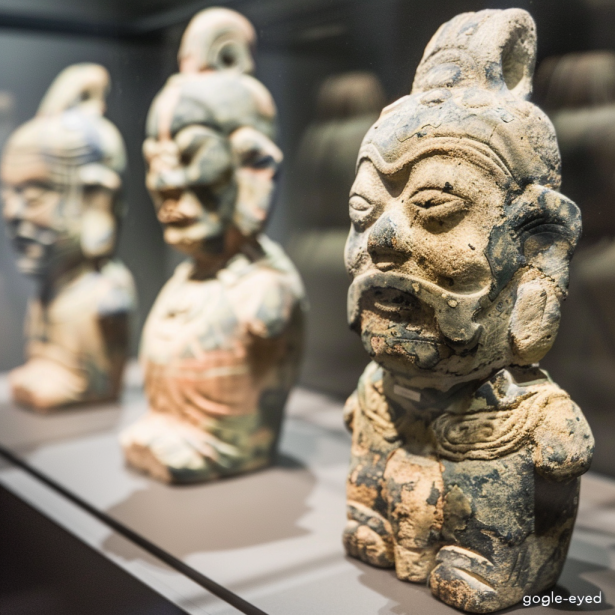Introduction
The Dogu figurines are mysterious clay artifacts dating back to Japan’s Jomon period (14,000–300 BCE). These intricate figurines, often featuring exaggerated facial features and elaborate patterns, have been found at various archaeological sites across Japan. Despite extensive study, the exact purpose of the Dogu remains unclear. Some theories suggest they were used in fertility rituals, while others propose they served as protective talismans or representations of deities. The figurines’ distinctive “goggle-eyed” appearance and other unique traits continue to intrigue researchers, offering a fascinating glimpse into the spiritual and cultural life of prehistoric Japan.
The Discovery of Dogu Figurines
Archaeological Context
Dogu figurines have been discovered at numerous archaeological sites throughout Japan, primarily dating from the middle to late Jomon period. The Jomon people were known for their complex pottery and settled village life, which marked a significant period in prehistoric Japan. The figurines are typically found in burial sites, residential areas, and storage pits, suggesting their importance in various aspects of Jomon life.
Variety and Design
Dogu come in various shapes and sizes, but they often share common features such as large eyes, small waists, and elaborate patterns. The most distinctive type is the “goggle-eyed” Dogu, characterized by its large, round eyes resembling goggles. Other types include heart-shaped faces, horned heads, and intricate body decorations.
Possible Purposes and Theories
Fertility Rituals
One prevalent theory is that Dogu figurines were used in fertility rituals. The exaggerated feminine features of many Dogu, such as large hips and breasts, suggest a connection to fertility and childbirth. These figurines may have been created to ensure successful pregnancies and the birth of healthy children.
Protective Talismans
Another theory posits that Dogu served as protective talismans. The figurines’ intricate designs and deliberate placement in graves and homes imply a protective function. They may have been used to ward off evil spirits or to bring good fortune to their owners.
Representations of Deities
Some researchers believe that Dogu figurines represent deities or supernatural beings. The “goggle-eyed” Dogu, with its otherworldly appearance, could symbolize a connection to the spiritual realm. These figurines might have been used in religious ceremonies or as objects of worship.
Healing and Medicine
Another intriguing theory suggests that Dogu were used in healing rituals. Some figurines show signs of deliberate breaking, possibly indicating a ritualistic act intended to transfer an ailment from a person to the figurine. Once broken, the ailment was thought to be vanquished.
Distinctive Features of Dogu Figurines
Goggle-Eyed Appearance
The most iconic feature of some Dogu figurines is their “goggle-eyed” appearance. These large, round eyes are believed to symbolize a connection to the supernatural, potentially indicating the figurine’s role in spiritual or shamanistic practices.
Elaborate Patterns and Decorations
Dogu are often adorned with intricate patterns and decorations. These designs may have symbolic meanings, possibly related to the Jomon people’s beliefs, social status, or rituals. The complexity of these patterns showcases the advanced artistic skills of the Jomon craftsmen.
Material and Construction
Dogu figurines are made from clay, carefully crafted and often painted or decorated with additional materials. The meticulous construction and varied styles highlight the cultural and regional diversity within the Jomon period.
Cultural and Historical Significance
Insights into Jomon Society
The study of Dogu figurines provides valuable insights into the spiritual and cultural life of the Jomon people. The figurines reflect the importance of fertility, protection, and religious practices in their society. They also demonstrate the Jomon people’s advanced craftsmanship and artistic expression.
Symbol of Prehistoric Japan
Dogu figurines have become a symbol of Japan’s prehistoric era. Their unique and mysterious nature captivates researchers and the public alike, representing a direct link to the distant past and the rich cultural heritage of ancient Japan.
Modern Research and Interpretations
Technological Advances in Study
Advances in technology, such as 3D scanning and imaging, have allowed researchers to study Dogu figurines in greater detail. These techniques help uncover new information about the construction, use, and significance of these artifacts.
Continued Debate and Exploration
Despite the wealth of information gathered, the exact purpose of Dogu figurines remains a topic of debate. New discoveries and interpretations continue to emerge, as researchers strive to piece together the complex puzzle of Jomon culture and beliefs.
Conclusion
The Dogu figurines are among the most enigmatic and fascinating artifacts from Japan’s prehistoric Jomon period. Their intricate designs, unique features, and mysterious purposes provide a captivating glimpse into the spiritual and cultural life of the Jomon people. As research continues and new technologies are applied, the understanding of these remarkable artifacts will undoubtedly deepen, revealing more about the rich history and heritage of ancient Japan.
FAQs
What are Dogu figurines?
Dogu figurines are clay artifacts from Japan’s Jomon period, characterized by their intricate designs and exaggerated features. They have been found at various archaeological sites across Japan.
What is the Jomon period?
The Jomon period (14,000–300 BCE) is a prehistoric era in Japan known for its distinctive pottery, settled village life, and advanced artistic expression.
What are the theories about the purpose of Dogu figurines?
Theories about Dogu figurines’ purposes include their use in fertility rituals, as protective talismans, representations of deities, or in healing rituals.
What is the significance of the “goggle-eyed” appearance of some Dogu?
The “goggle-eyed” appearance of some Dogu figurines may symbolize a connection to the supernatural or spiritual realm, indicating their potential role in shamanistic practices.
How do Dogu figurines reflect Jomon society?
Dogu figurines provide insights into the spiritual and cultural beliefs of the Jomon people, highlighting the importance of fertility, protection, and religious practices in their society.
How has modern technology advanced the study of Dogu figurines?
Modern technology, such as 3D scanning and imaging, has allowed researchers to study Dogu figurines in greater detail, uncovering new information about their construction, use, and significance.

